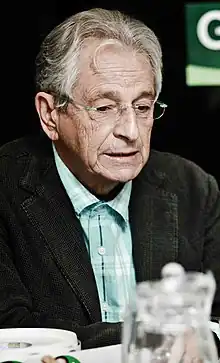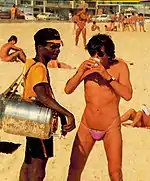Fernando Gabeira
Fernando Paulo Nagle Gabeira (Portuguese pronunciation: [feʁˈnɐ̃du ɡaˈbejɾɐ]; born 17 February 1941) is a Brazilian politician, author and journalist. He was a federal representative for the state of Rio de Janeiro from 1995 to 2011.
Fernando Gabeira | |
|---|---|
 | |
| Member of the Chamber of Deputies | |
| In office 1 February 1995 – 1 February 2011 | |
| Constituency | Rio de Janeiro |
| Personal details | |
| Born | Fernando Paulo Nagle Gabeira 17 February 1941 Juiz de Fora, Minas Gerais, Brazil |
| Political party | PV (1989–2002; 2003–present) |
| Other political affiliations | PT (1986–1989; 2002–2003) |
| Spouses | Yamê Reis
(m. 1983; div. 1999)Neila Tavares (m. 2005) |
| Children | 2, including Maya |
| Relatives | Leda Nagle (cousin) |
| Profession | Journalist |
| Known for | Kidnapping of Charles Elbrik |
He is best known for his book O que é isso, companheiro? (literally "What is this, comrade?") written in 1979. The book tells of the armed resistance to the military dictatorship in Brazil, and particularly describes the 1969 episode of the kidnapping of the American ambassador Charles Burke Elbrick, in which Gabeira took part as a member of MR8, a group trying to fight the military dictatorship installed in Brazil five years prior.
The book was made into a movie in 1997, titled Four Days in September in English. The movie was nominated for many awards, including an Oscar at the Best Foreign Language Film at the 70th Academy Awards.
Because of his role in the kidnapping of the ambassador Charles Burke Elbrick, Gabeira was considered a terrorist[1][2] and banned to enter the United States and its territories until 2009.[3][4] Gabeira has asked for a visa revision three times, and was denied each time.[5] In a May 2009 interview with Ragga, Gabeira said he was in error in kidnapping the American ambassador in 1969 and that he would never participate in such activity now.
Biography
Born February 17, 1941, in Juiz de Fora, Minas Gerais, Fernando Gabeira was one of the founding members of the Green Party of Brazil, but left the group in 2002 to join the Workers' Party. He became known for his positions sometimes considered controversial on certain societal subjects, such as the professionalization of prostitution, same-sex marriage and the legalization of cannabis. Recently he rejoined the Greens, due to his disappointment with Luiz Inácio Lula da Silva's government, and also because of the way the Worker's Party was dealing with its remaining members.
.tif.jpg.webp)
During his exile in the 1970s, Gabeira lived in several countries including Chile, Sweden and Italy. In Stockholm, where he spent most of his exile, he studied anthropology at Stockholm University and worked as a journalist as well as a metro conductor [6] He returned to Brazil in 1979, where he began to act as a journalist and writer, defending the end of the military regime.
After 1985, Fernando Gabeira started to support the causes of minority rights and the environment.
Gabeira has repeatedly voiced his ideological support for the legalization of marijuana, for equal marriage laws and for the legalization of abortion. He ran for the mayoral office of Rio de Janeiro in 2008, and was defeated by Eduardo Paes in the runoff round on October 26 (49.3% – 50.7%). He also lost a bid to become Governor of Rio de Janeiro in 2010.
The knitted swimsuit affair

He lived for a decade in exile from Brazil during the military dictatorship, and returned to his country in 1979. Just after his return, a photo of Gabeira wearing a very small knitted swimsuit on Ipanema beach turned into a national scandal. Many years later, Gabeira revealed that his scandalous bathing suit was indeed the bottom part of one of his cousin Leda Nagle's bikinis.[7]
Literary career
In 1979, he wrote the book O Que É Isso, Companheiro?, about his participation in the armed struggle against the military regime in Brazil (1964–1985) and his subsequent exile in Europe. The book won the Jabuti Literature Prize in the biography and (or) memories category in 1980 and was made into the film Four Days in September by filmmaker Bruno Barreto in 1997.
In 1980, he released The Twilight of the Male, a continuation of O Que É Isso, Companheiro?.
In 1981, he launched Entradas e Bandeiras , a book in which he chronicles his return to Brazil and his abandonment of Marxist ideology, starting to fight for issues such as ecology, pleasure and sexual freedom. In the same year, he launched Hôte da utopia, in which he deepens his new ideological positioning.
In 1982, he launched Sinais de vida on Planeta Minas, in which he tells the feminist struggles against the conservative society of the Brazilian state of Minas Gerais, through the biographies of five women from Minas Gerais. Among them, Dona Beja and Ângela Diniz .
In Goiânia, 57th street – the nuclear plant in the land of the sun, launched in 1987, Gabeira narrated the radiological accident that occurred in Goiânia in September of that year.
In 2000, he launched the book Marijuana , in which he discusses the decriminalization of its use, its therapeutic functions, the social role it plays etc.
In 2006, he launched the book Navigation in the fog, under a Creative Commons license, dealing with the Leech Scandal in 2005.
In 2012, he released the book Onde Está Tudo Aquilo Agora .
In 2017, he released the book Tropical Democracy: An Apprentice's Notebook, in which he recounts the events of Dilma Rousseff's impeachment, as well as an overview of the last thirty years of Brazilian democracy.
Family
Gabeira is the son of Paulo Gabeira and Isabel Nagle, both Lebanese immigrants.[8][9] His surname was aportuguesado (expression meaning transformed to fit Portuguese language sounds) from the transliterations Jabara or Gebara (in Arabic : جبارة).[10]
He was married to Brazilian fashion designer, Yamê Reis, with whom he had two daughters, Tami and Maya. The couple divorced in 1999.
His daughter Maya has since become a top female big wave surfer. She said the trauma of her parents' divorce drove her to leave home at age 15 and go to Australia on a student program. She moved to Hawaii in 2004 at age 17 to surf world class waves. She quickly emerged as the world's top female big-wave surfer, winning global championships surfing challenging spots like Mavericks, Waimea, Todos Santos, and South Africa's shark-infested "Dungeons". She told Huck Magazine in 2007: "My dad and I are very similar. All the energy he's put into improving the country I have as well – only I've been channeling it into my surfing." She added: "My dad has a really strong character, is incredibly bright and I’ve learned a lot from him."
References
- "Folha de S.Paulo - EUA negarão visto para Gabeira ir à ONU (com foto) - 03/12/98". www1.folha.uol.com.br. Retrieved 2022-11-07.
- "Militante da ALN, que sequestrou embaixador dos EUA, obtém visto". revistaforum.com.br (in Brazilian Portuguese). Retrieved 2022-11-07.
- Zahar, Andre (16 October 2008). "Em debate, Paes e Gabeira admitem ter fumado maconha no passado" [In debate, Paes and Gabeira admit to having smoked marijuana in the past]. www1.folha.uol.com.br (in Portuguese).
- "O incrível sequestro de Charles Elbrick - SUPERINTERESSANTE". Archived from the original on 2009-03-12. Retrieved 2009-10-21.
- "Ex-militante recebe visto dos Estados Unidos". Tribuna do Norte. Retrieved 2018-07-11.
- https://segueuserfiles.middlebury.edu/.../Fernando%20Gabeira.doc%5B%5D
- "ZAZ – ISTOÉ GENTE – Anistia na tanga de Gabeira". www.terra.com.br. Retrieved 2018-07-11.
- Revista IstoÉ (8 December 2017). "istoe.com.br/um-homem-do-presente/". 2017-02-08. Retrieved 2019-02-24.
- Maalouf, Ramez Philippe (2007). "Review of Atlas du Liban: territoires et société, edited by Éric Verdeil, Ghaleb Faour and Sébastien Velut, french-lebanese edition by IFPO (Institut Français du Proche-Orient) and CNRS Liban (Conseil National de la Recherche Scientifique – Liban) Beirut, 2007". Confins. Revue Franco-Brésilienne de Géographie / Revista Franco-Brasilera de Geografia (4). Retrieved 2019-02-24.
- Luis Nassif (2012-06-25). "Como Veja tratou a imigração árabe no Brasil". Retrieved 2019-02-24.
External links
- Official website (in Portuguese)
- Fernando Gabeira on Facebook
- Fernando Gabeira on Instagram
- Fernando Gabeira on Twitter
- Fernando Gabeira at IMDb
- Interview to journalist Sidney Rezende (in Portuguese)
- Interview with Ragga magazine, discussing how he's changed since the kidnapping, identifies daughter Tami. (in Portuguese)
- Maya Gabeira's interview with Huck magazine, discussing her father. (in English)
- Maya Gabeira emerges as women's surfing champion, from The Guardian discussing her family life (in English)
- Surf champ Maya Gabeira discusses for The Independent her upbringing with her father (in English)
- Interview with Maya Gabeira discussing her upbringing for Women's Health magazine; mother identified (in English)